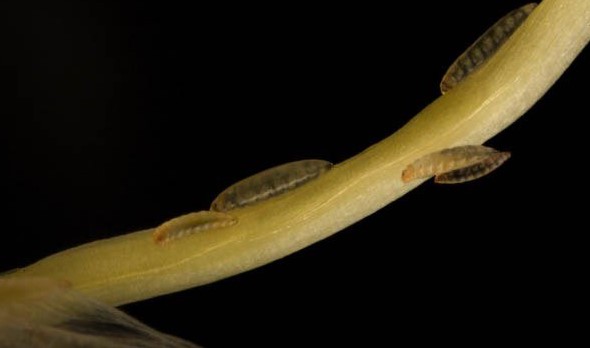By John Tooker
As silage harvest progresses, growers are starting to think about planting small grains, either as cover crops or for grain or silage. Planting wheat is a common choice in Pennsylvania, but brings a concern that is easily overlooked: Hessian fly. While many Pennsylvania growers have never encountered Hessian flies (Figure 1), the past decade or so has seen an increasing number of outbreaks in eastern states (VA, NC) in wheat (and to a lesser degree barley, and even less with cereal rye, which tends to have good resistance against Hessian fly).
Hessian fly has not been common in the recent past because most farmers plant wheat after “fly-free dates” – dates after which egg-laying Hessian fly adults are not likely to be active. For best estimates of fly-free dates in PA, see
our fact sheet on Hessian fly . Recognize, however, that these fly-free dates are likely imperfect given the trends for warmer years, so proper date is likely to be a little later, so I would encourage folks to wait a few days more if you can. Also, if your farm is at a higher elevation, the date is probably a little earlier than the rest of your county—this is an inexact science at this point, so just do your best!
Hessian fly has two generations per year, one in spring and one in fall. Flies from the fall brood tend to be active in mid- to late September and are active only for a few days—they are small and difficult to notice. Females prefer to lay their eggs on wheat and barley. These eggs hatch and tiny maggots move down to the base of leaves to feed at the crown of the plant (Figure 2). Feeding by one maggot can cause permanent stunting of plants, limiting growth and grain yield. Planting after the fly-free date is an effective control method because it avoids having large numbers of young host plants available to receive eggs when adult flies are active. If the flies emerge and die off before the new wheat plants emerge, the crop cannot be infested. Maggots can survive on native grasses, but populations do not appear to thrive until they find small grain hosts, particularly wheat.

Figure 2. Hessian fly larvae feeding on a wheat stem (Photo by Peggy Greb, USDA Agricultural Research Service, Bugwood.org)
With good adoption of small grains as cover crop species, some growers have been planting wheat and barley earlier. These early-planted fields are available for egg-laying female flies and then can foster populations of Hessian fly larvae that can then emerge as adults in spring and further infest fields. Insecticides are generally not effective for control of Hessian fly because adults live very briefly and maggots are hidden among leaf sheaths and do not easily receive insecticides. Therefore, the best tactics for farmers are to adhere to the fly-free dates and plant Hessian fly-resistant varieties of wheat or barley. If you are in the practice of planting wheat or barley as cover crops well before the fly-free dates, it is probably prudent to assess local Hessian fly populations by scouting that early-planted small grain cover crop (particularly wheat) for hessian fly-induced stunting.
Source : psu.edu